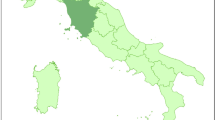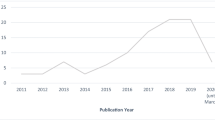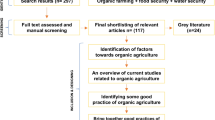Abstract
A reliable and comparative fungicide index (FI) was assessed to describe the fungicide use in the agricultural land of Europe during the first 20 years of the twenty-first century (from 2000 to 2018). FI is not uniform across EU27. The highest mean value (1.34 kg ha−1) of FI was observed in Southern Europe compared to the other sub-regions of the EU, while this variation existed mainly due to the inorganic fungicide use. The mean value of inorganic fungicide index (FIinorg) in agricultural land area (AL) in Southern Europe was 1.69 kg ha−1, about three times higher than the average value (0.63 kg ha−1) across the EU. The higher mean values of organic fungicide index (FIorg) in conventional agricultural land area (convAL) was observed in Western Europe (0.54 kg ha−1), while an upward trend was observed in the FIorg mainly in Central and Eastern and Northern Europe during the period 2000–2018. Linear discriminant analysis (LDA) of 19 agri-environmental indicators (FI, FIorg, FIinorg, agricultural land use, crop groups, fungicide chemical families) was assessed to describe this differentiation of the four geographical sub-regions of EU. Despite the linear growth of the organic farmland area, the fungicide use in the agricultural land remained relatively stable, while the larger the farm size (ha), the greater the amounts (kg of a.s.) of fungicides which were used in the cropland of EU. The impact assessment of each variable which was examined on the FI could contribute to the implementation of European agricultural policy, reducing in this way the environmental impact.










Similar content being viewed by others
Data Availability
Not applicable.
Code Availability
Not applicable.
References
Ali, M. P., Kabir, M. M. M., Haque, S. S., Qin, X., Nasrin, S., Landis, D., ... & Ahmed, N. (2020). Farmer's behavior in pesticide use: Insights study from smallholder and intensive agricultural farms in Bangladesh. Science of the Total Environment, 747, 141160.
Atwood, D., & Paisley-Jones, C. (2017). Pesticides industry sales and usage: 2008–2012 market estimates (p. 20460). US Environmental Protection Agency.
Ballabio, C., Panagos, P., Lugato, E., Huang, J. H., Orgiazzi, A., Jones, A., ... & Montanarella, L. (2018). Copper distribution in European topsoils: An assessment based on LUCAS soil survey. Science of the Total Environment, 636, 282–298.
Bonanno, A., Materia, V. C., Venus, T., & Wesseler, J. (2017). The plant protection products (PPP) sector in the European Union: A special view on fungicides. European Journal of Development Research, 29(3), 575–595.
Brent, K. J., & Hollomon, D. W. (1995). Fungicide resistance in crop pathogens: How can it be managed? (Vol. 1, p. 48). GIFAP.
Bush, E.A. (2018). Reducing pesticide use in the home lawn and garden. Virginia Cooperative Extension. VCE Publications 450–725.
Büyüköztürk, Ş, & Çokluk-Bökeoğlu, Ö. (2008). Discriminant function analysis: Concept and application. Egitim Arastirmalari - Eurasian. Journal of Education Research, 33, 73–92.
Commission Implementing Regulation (EU) 2019/677 of 29 April 2019 Concerning the Non-Renewal of the Approval of the Active Substance Chlorothalonil in Accordance with Regulation (EC) No. 1107/2009 of the European Parliament and of the Council Concerning the Placing of Plant Protection Products on the Market, and Amending Commission Implementing Regulation (EU) No. 540/2011. Official Journal of the European Union, L114, 15-17.
Devault, D. A., & Pascaline, H. (2014). Efficiency of pesticide alternatives in non-agricultural areas. Pesticides: Toxic Aspects, 1.
EFSA (European Food Safety Authority). (2018). The 2016 European Union report on pesticide residues in food. EFSA Journal, 16(7), e05348.
EFSA (European Food Safety Authority), Anastassiadou, M., Bernasconi, G., Brancato, A., Carrasco Cabrera, L., Greco, L., ... & Verani, A. (2020). Modification of the existing maximum residue levels for mandipropamid in kohlrabies and herbs and edible flowers. EFSA Journal, 18(1), e05958.
European Commission (2019). Communication from the Commission to the European Parliament, the European Council, the Council, the European Economic and Social Committee and the Committee of the Regions: The European Green Deal. https://ec.europa.eu/info/sites/default/files/european-green-deal-communication_en.pdf
Eurostat (2021). Online data code: APRO_CPSH “Crop production in EU standard humidity”, last update: 21/04/2021, view: CUSTOM DATASET.
Eurovoc, 2021, 7206 Europe https://publications.europa.eu/en/web/eu-vocabularies/th-concept-scheme/-/resource/eurovoc/100277 (accessed April 12, 2021)
FAOSTAT (2021a). Domain: Land Use, Element: Area, Area: separately each of 27 Member States of EU, Item Codes: 6610, 6620, 6621, 6650, 6655.
FAOSTAT (2021b). Domain: Pesticides Use, Element: Agricultural Use, Area: separately each of 27 Member States of EU, Item Codes: 1320, 1321, 1322, 1323, 1324, 1325, 1326, 1327, 1328, 1329, 1330.
FiBL (2021): Area data on organic agriculture in Europe 2000–2017. The Statistics.FiBL.org website maintained by the Research Institute of Organic Agriculture (FiBL), Frick, Switzerland. Available at https://statistics.fibl.org/europe/key-indicators-europe.html. Accessed February 10, 2021.
Field, A. (2009). Discovering Statistics Using SPSS (3rd ed.). Sage Publications Ltd.
Fisher, M. C., Henk, D. A., Briggs, C. J., Brownstein, J. S., Madoff, L. C., McCraw, S. L., & Gurr, S. J. (2012). Emerging fungal threats to animal, plant and ecosystem health. Nature, 484(7393), 186–194.
Garthwaite, D., Barker, I., Ridley, L., Mace, A., Parrish, G., MacArthur, R., & Lu, Y. (2017). Arable crops in the United Kingdom 2016. Pesticide usage survey report 271.
Geiger, F., Bengtsson, J., Berendse, F., Weisser, W. W., Emmerson, M., Morales, M. B., ... & Inchausti, P. (2010). Persistent negative effects of pesticides on biodiversity and biological control potential on European farmland. Basic and Applied Ecology, 11(2), 97–105.
Hakala, K., Hannukkala, A., Huusela-Veistola, E., Jalli, M., & Peltonen-Sainio, P. (2011). Pests and diseases in a changing climate a major challenge for Finnish crop production. Agricultural and Food Science, 20(1), 3–14.
Janz, D. M. (2014). Dithiocarbamates. In P. Wexler (Ed.), Encyclopedia of toxicology (3rd ed., Vol. 2, pp. 212–214). Elsevier. https://doi.org/10.1016/B978-0-12-386454-3.00139-1
Karabagias, I. K., Louppis, P. A., Karabournioti, S., Kontakos, S., Papastephanou, C., & Kontominas, M. G. (2017). Characterization and geographical discrimination of commercial Citrus spp. honeys produced in different Mediterranean countries based on minerals, volatile compounds and physicochemical parameters, using chemometrics. Food Chemistry, 217, 445–455.
Komárek, M., Čadková, E., Chrastný, V., Bordas, F., & Bollinger, J. C. (2010). Contamination of vineyard soils with fungicides: A review of environmental and toxicological aspects. Environment International, 36(1), 138–151.
Linhart, C., Panzacchi, S., Belpoggi, F., Clausing, P., Zaller, J. G., & Hertoge, K. (2021). Year-round pesticide contamination of public sites near intensively managed agricultural areas in South Tyrol. Environmental Sciences Europe, 33(1), 1–12.
Manktelow, D., Stevens, P., Walker, J., Gurnsey, S., Park, N., Zabkiewicz, J., ... & Rahman, A. (2005). Trends in pesticide use in New Zealand: 2004 (p. 74). Ministry for the Environment.
Meftaul, I. M., Venkateswarlu, K., Dharmarajan, R., Annamalai, P., & Megharaj, M. (2020). Pesticides in the urban environment: A potential threat that knocks at the door. Science of The Total Environment, 711, 134612.
Metcalfe, C. D., Helm, P., Paterson, G., Kaltenecker, G., Murray, C., Nowierski, M., & Sultana, T. (2019). Pesticides related to land use in watersheds of the Great Lakes basin. Science of the Total Environment, 648, 681–692.
Mnif, W., Hassine, A. I. H., Bouaziz, A., Bartegi, A., Thomas, O., & Roig, B. (2011). Effect of endocrine disruptor pesticides: A review. International Journal of Environmental Research and Public Health, 8(6), 2265–2303.
Nowell, L. H., Moran, P. W., Bexfield, L. M., Mahler, B. J., Van Metre, P. C., Bradley, P. M., ... & Qi, S. L. (2021). Is there an urban pesticide signature? Urban streams in five US regions share common dissolved-phase pesticides but differ in predicted aquatic toxicity. Science of The Total Environment, 148453.
Panagos, P., Ballabio, C., Lugato, E., Jones, A., Borrelli, P., Scarpa, S., ... & Montanarella, L. (2018). Potential sources of anthropogenic copper inputs to European agricultural soils. Sustainability, 10(7), 2380.
Pimentel, D., & Peshin, R. (Eds.). (2014). Integrated pest management: Pesticide problems (Vol. 3). Springer Science & Business Media.
Provenzano, M. R., El Bilali, H., Simeone, V., Baser, N., Mondelli, D., & Cesari, G. (2010). Copper contents in grapes and wines from a Mediterranean organic vineyard. Food Chemistry, 122(4), 1338–1343.
Purola, T., Lehtonen, H., Liu, X., Tao, F., & Palosuo, T. (2018). Production of cereals in northern marginal areas: An integrated assessment of climate change impacts at the farm level. Agricultural Systems, 162, 191–204.
Sharma, A., Kumar, V., Shahzad, B., Tanveer, M., Sidhu, G. P. S., Handa, N., ... & Thukral, A. K. (2019). Worldwide pesticide usage and its impacts on ecosystem. SN Applied Sciences, 1(11), 1–16.
Simon, S., Brun, L., Guinaudeau, J., & Sauphanor, B. (2011). Pesticide use in current and innovative apple orchard systems. Agronomy for Sustainable Development, 31(3), 541–555.
Sridhar, K. R., Bärlocher, F., Krauss, G.-J., & Krauss, G. (2005). Response of aquatic hyphomycete communities to changes in heavy metal exposure. International Review of Hydrobiology, 90, 21–32.
Stoate, C., Boatman, N. D., Borralho, R. J., Carvalho, C. R., De Snoo, G. R., & Eden, P. (2001). Ecological impacts of arable intensification in Europe. Journal of Environmental Management, 63(4), 337–365.
Strube, C., Raulf, M. K., Springer, A., Waindok, P., & Auer, H. (2020). Seroprevalence of human toxocarosis in Europe: A review and meta-analysis. Advances in Parasitology, 109, 375–418.
Thomas, M. R. (1999). Guidelines for the collection of pesticide usage statistics within agriculture and horticulture. Organisation for Economic Cooperation and Development.
Tona, E., Calcante, A., & Oberti, R. (2018). The profitability of precision spraying on specialty crops: A technical–economic analysis of protection equipment at increasing technological levels. Precision Agriculture, 19(4), 606–629.
Triantafyllidis, V., Hela, D., Papadaki, M., Bilalis, D., & Konstantinou, I. (2012). Evaluation of mobility and dissipation of mefenoxam and pendimethalin by application of CSTR model and field experiments using bare and tobacco tilled soil columns. Water, Air, & Soil Pollution, 223(4), 1625–1637.
Triantafyllidis, V., Hela, D., & Patakioutas, G. (2013). Environmental behavior of the fungicide metalaxyl in experimental tobacco field. Journal of Environmental Science and Health, Part B, 48(9), 747–757.
Triantafyllidis, V., Zotos, A., Kosma, C., & Kokkotos, E. (2020). Environmental implications from long-term citrus cultivation and wide use of cu fungicides in mediterranean soils. Water, Air, & Soil Pollution, 231(5), 1–17.
Urruty, N., Deveaud, T., Guyomard, H., & Boiffin, J. (2016). Impacts of agricultural land use changes on pesticide use in French agriculture. European Journal of Agronomy, 80, 113–123.
USEPA (US Environmental Protection Agency), 2003. Pesticide Fact Sheet, Boscalid, <http://www.epa.gov/opprd001/factsheets/boscalid.pdf> (accessed 23.01.12).
USEPA (US Environmental Protection Agency), 2005. Pesticide Fact Sheet Imazalil
USEPA (US Environmental Protection Agency), 2020. Pesticide Product Label, CSI 19–349 Fludioxonil,08/04/2020
USGS Pesticide National Synthesis Project. Preliminary Pesticide Us Estimates For 2016. https://water.usgs.gov/nawqa/ pnsp/usage/maps/county-level/.
Zubrod, J. P., Feckler, A., Englert, D., Koksharova, N., Rosenfeldt, R. R., Seitz, F., ... & Bundschuh, M. (2015). Inorganic fungicides as routinely applied in organic and conventional agriculture can increase palatability but reduce microbial decomposition of leaf litter. Journal of Applied Ecology, 52(2), 310–322.
Zubrod, J. P., Bundschuh, M., Arts, G., Brühl, C. A., Imfeld, G., Knäbel, A., ... & Schäfer, R. B. (2019). Fungicides: An overlooked pesticide class? Environmental Science & Technology, 53(7), 3347–3365.
European Environment Agency (EEA), (2018). Environmental Indicator Report 2018, In Support to the Monitoring of the Seventh Environment Action Programme. Copenhagen: EEA Report No 19/2018.
Ritchie, H. & Roser, M. (2019), ‘Land Use’, Our World in Data, September 2019, https://www.ourworldindata.org/land-use (accessed 10 June 2021).
Kabata-Pendias, A., & Mukherjee, A. B. (2007). Trace elements from soil to human. Springer Science & Business Media.
Funding
The research leading to these results received funding from programme MEDICUS of the University of Patras “ΜΟΔΥ ΕΛΚΕ”, research.upatras.gr; under Grant Agreement No 81667—programme MEDICUS.
Author information
Authors and Affiliations
Contributions
Conceptualization: Vassilios Triantafyllidis; methodology: Vassilios Triantafyllidis, Chariklia Kosma; formal analysis and investigation: Vassilios Triantafyllidis, Chariklia Kosma, Ioannis Konstantinos Karabagias, Anastasios Zotos, Antonios Pittaras, George Kehayias; writing—original draft preparation: Vassilios Triantafyllidis, Chariklia Kosma, Ioannis Konstantinos Karabagias, Antonios Pittaras; writing—review and editing: Anastasios Zotos, George Kehayias, Vassilios Triantafyllidis; funding acquisition: Vassilios Triantafyllidis; resources: Vassilios Triantafyllidis, George Kehayias; supervision: Vassilios Triantafyllidis.
Corresponding author
Ethics declarations
Ethics Approval
Not applicable.
Consent to Participate
Not applicable.
Consent for Publication
Not applicable.
Competing Interests
The authors declare no competing interests.
Additional information
Publisher's Note
Springer Nature remains neutral with regard to jurisdictional claims in published maps and institutional affiliations.
Supplementary Information
Below is the link to the electronic supplementary material.
Rights and permissions
About this article
Cite this article
Triantafyllidis, V., Kosma, C., Karabagias, I. et al. Fungicides in Europe During the Twenty-first Century: a Comparative Assessment Using Agri-environmental Indices of EU27. Water Air Soil Pollut 233, 52 (2022). https://doi.org/10.1007/s11270-022-05529-5
Received:
Accepted:
Published:
DOI: https://doi.org/10.1007/s11270-022-05529-5




